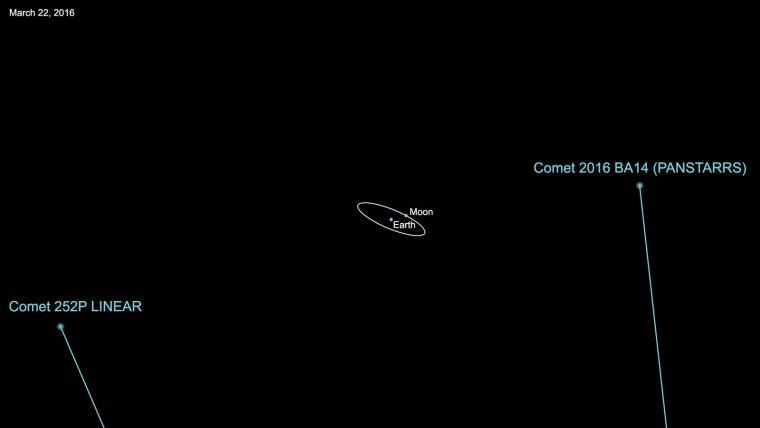| News / Science News |
A 'Tail' of Two Comets
NASA | MARCH 19, 2016
Two comets that will safely fly past Earth later this month may have more in common than their intriguingly similar orbits. They may be twins of a sort.

Comet 252P/LINEAR and comet P/2016 BA14. Image credit: NASA/JPL-Caltech
Comet P/2016 BA14 was discovered on Jan. 22. It was initially thought to be an asteroid, but follow-up observations, showed a faint tail, revealing that the discovery was, in fact, a comet. The orbit of this newly discovered comet, however, held yet another surprise. Comet P/2016 BA14 follows an unusually similar orbit to that of comet 252P/LINEAR, which was discovered on April 7, 2000. The apparent coincidence may be an indication of twin nature in that comet. P/2016 BA14 is roughly half the size of comet 252P/LINEAR and might be a fragment that calved off sometime in the larger comet's past.
Perhaps during a previous pass through the inner-solar system, or during a distant flyby of Jupiter, a chunk that we now know of as BA14 might have broken off of 252P.
Comet 252P/LINEAR, approximately 750 feet (230 meters) in size, will zip past Earth on Monday, March 21 at a range of about 3.3 million miles (5.2 million kilometers). The following day, comet P/2016 BA14 will safely fly by our planet at a distance of about 2.2 million miles (3.5 million kilometers). This will be the third closest flyby of a comet in recorded history next to comet D/1770 L1 (Lexell) in 1770 and comet C/1983 H1 (IRAS-Araki-Alcock) in 1983.
The time of closest approach for comet 252P/LINEAR on March 21 will be around 5:14 a.m. PDT (8:14 a.m. EDT). The time of closest approach for P/2016 BA14 on March 22 will be around 7:30 a.m. PDT (10:30 a.m. EDT).
YOU MAY ALSO LIKE



